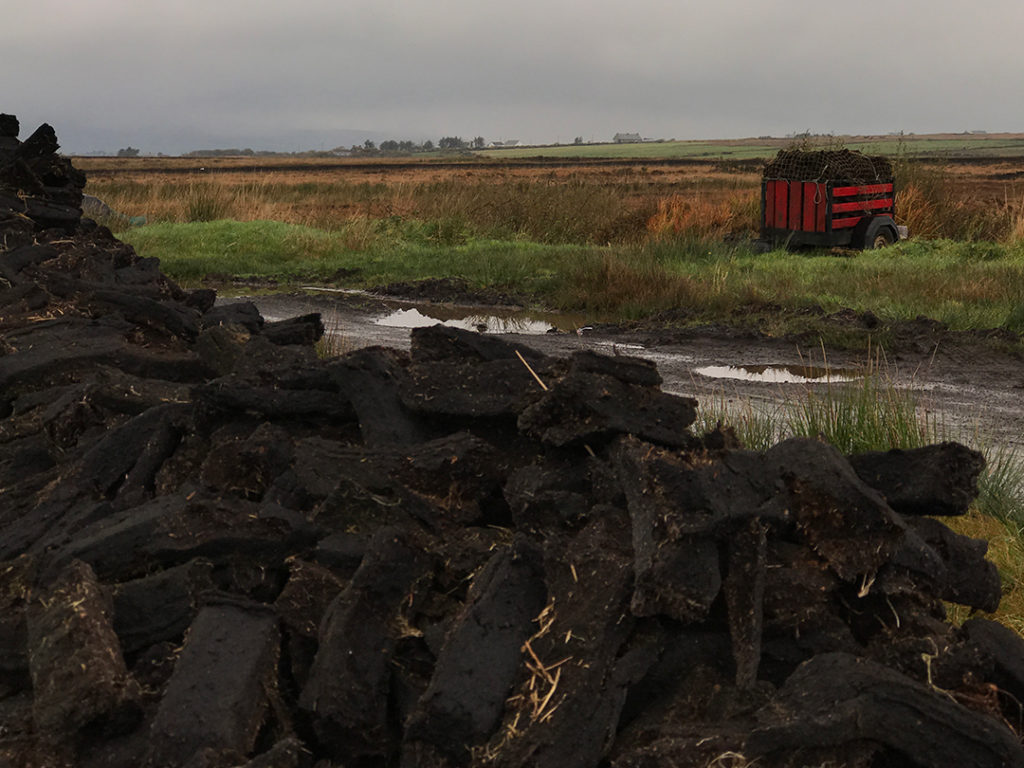
Ireland
Turf
Peat: leaves, wood and water compressed into the earth

General Description / Cultural Significance
Turf, often referred to as peat, consists of sods dug from the vast boglands that cover much of Ireland. For thousands of years, turf has been a primary source of heat in Irish homes, giving it an iconic status in Irish culture. Formed from the slow compression of decayed vegetation—leaves, wood, and water—peat accumulates over millennia in Ireland’s boggy, moist regions. Harvesting turf involves cutting and drying the sods, which then release an earthy, woodsy aroma when burned. This distinct scent is intimately tied to Irish identity and is widely recognized as the most culturally significant aroma in the country.
In traditional Irish households, the turf fire has been central to daily life, serving as a gathering spot where generations have socialized, shared stories, and passed down oral histories. The unique scent of turf smoke permeates Irish homes and landscapes, symbolizing warmth, resilience, and community. Many people in Ireland still recall the sensory memory of sitting by the turf fire—the warmest, most welcoming place in any Irish home.
Peat bogs are not only essential to Irish history and culture but also hold vast ecological and economic value. Like rainforests in other parts of the world, Ireland’s peatlands are a critical natural asset. These bogs, where peat accumulates in depths of up to 45 centimeters, are composed of the partly decayed remains of plants and trees such as yew, oak, pine, birch, heather, and gorse. Some of the oldest peat deposits in Ireland’s boglands are estimated to be around 9,000 years old, offering a direct connection to Ireland’s ancient landscape and ecological heritage.
Climate Change/Conservation Status
In the absence of significant oil, gas, or coal reserves, Ireland historically relied on turf for fuel. However, the extraction of peat involves draining bogs, which accelerates the breakdown of organic matter and releases greenhouse gases. When dried peat bricks are burned, additional emissions are released, exacerbating Ireland’s carbon footprint.
Peatlands take thousands of years to develop, making their preservation essential. Once degraded, restoring the biodiversity, climate-regulating capacity, and historical richness of these ecosystems is exceedingly difficult. Given the pressing challenge of climate change, Ireland is now shifting away from turf extraction, recognizing the crucial role that peatlands play in carbon sequestration and biodiversity conservation.
Ireland’s climate has been warming notably, with six of the warmest years on record occurring since 1990, and frost seasons are gradually shortening. Ocean acidification is also impacting rain patterns, altering ecosystems and stressing native species. While Ireland has committed to lowering emissions and becoming more climate-resilient through initiatives like large-scale tree planting, the agricultural sector remains the primary source of greenhouse gas emissions. The nation’s agricultural practices, especially those involving over seven million cattle, contribute significantly to emissions due to the use of nitrogen-based fertilizers and methane emissions from livestock. In recent years, strategies to curb emissions have included controversial measures such as the culling of dairy cows.
In response to these challenges, Ireland has implemented a plan to halt turf extraction and reassess the value of bogs as critical carbon sinks. Sustainable energy sources, particularly wind, are being prioritized to achieve the ambitious goal of net-zero emissions by 2050. Nonetheless, Ireland’s agricultural expansion plans, focused on increasing food output, conflict with its emissions reduction targets, as noted in a report by The Institute of International and European Affairs. This conflict highlights the complex balancing act Ireland faces between economic growth and environmental responsibility.
Extreme weather events underscore the urgency of these initiatives. On October 16, 2017, Hurricane Ophelia, the most powerful eastern Atlantic hurricane recorded, struck Ireland, bringing violent winds, intense rainfall, and widespread flooding. As Ireland’s climate grows warmer and wetter, storms have become more severe. The recent October 2023 marked the wettest month on record in Ireland, resulting in extensive flooding and further illustrating the vulnerability of the region to climate impacts.
Ireland’s shifting approach reflects a deepening recognition of peatlands as not only cultural touchstones but also indispensable resources in the fight against climate change. Through restoration efforts, sustainable energy development, and a reevaluation of traditional land use practices, Ireland is moving towards a future that balances cultural heritage with ecological preservation.
Alternate Names
Bogs
Boglands
Peatlands
Sources
Cooke, K., 2017. Ireland’s climate plan offers vague intentions. Smarter Shift and Energy Mix Productions. [website]
Curtin, J., and Arnold, T., 2016. A Climate-Smart Pathway for Irish Agricultural Development. The Institute of International and European Affairs.
EPA, n.d. What Impact Will Climate Change Have For Ireland? Environmental Protection Agency. [website]
Permanent Mission of Ireland to the United Nations. This statement can be found on the World Sensorium original website.

